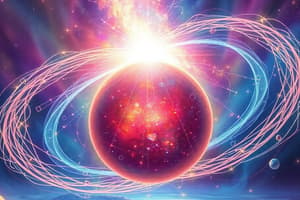Podcast
Questions and Answers
Which state of matter can be poured and takes the shape of its container?
Which state of matter can be poured and takes the shape of its container?
- Solid
- Liquid (correct)
- Gas
- None of the above
What term describes the phenomenon when a substance changes from a liquid to a gas?
What term describes the phenomenon when a substance changes from a liquid to a gas?
- Sublimation
- Deposition
- Evaporation (correct)
- Condensation
Which of the following statements is true regarding solids?
Which of the following statements is true regarding solids?
- Solids do not change shape when placed in a different container. (correct)
- Solids can be easily compressed.
- Solids have variable volume.
- Solids flow to take the shape of their container.
Which property accurately describes gases?
Which property accurately describes gases?
What happens to a substance when it is heated and expands?
What happens to a substance when it is heated and expands?
What must occur for a gas to occupy a smaller volume?
What must occur for a gas to occupy a smaller volume?
What is the primary reason that gases can be compressed easily?
What is the primary reason that gases can be compressed easily?
When is a hypothesis considered a theory?
When is a hypothesis considered a theory?
How are the particles arranged in a solid?
How are the particles arranged in a solid?
What allows liquids to change shape?
What allows liquids to change shape?
Which statement is true about gas particles?
Which statement is true about gas particles?
What is a characteristic property of solids?
What is a characteristic property of solids?
Why can gases change both shape and volume?
Why can gases change both shape and volume?
What property prevents a solid's volume from being easily reduced?
What property prevents a solid's volume from being easily reduced?
In which state do particles touch each other but can still move past one another?
In which state do particles touch each other but can still move past one another?
Which of the following is NOT true about particles in solids?
Which of the following is NOT true about particles in solids?
What describes the particle arrangement in a solid?
What describes the particle arrangement in a solid?
What allows particles in a liquid to move past each other?
What allows particles in a liquid to move past each other?
Why do gases have no fixed shape or volume?
Why do gases have no fixed shape or volume?
Which statement accurately applies to the properties of solids?
Which statement accurately applies to the properties of solids?
What term is used to describe a space where there are no particles?
What term is used to describe a space where there are no particles?
What characteristic of gases allows them to be compressed?
What characteristic of gases allows them to be compressed?
How does particle theory explain the fluidity of liquids?
How does particle theory explain the fluidity of liquids?
Which of the following is a weakness of particle theory?
Which of the following is a weakness of particle theory?
Flashcards are hidden until you start studying
Study Notes
States of Matter
- Matter can be classified into three states: solids, liquids, and gases.
- Solids have a fixed shape and volume, cannot be compressed, and cannot be poured.
- Liquids take the shape of their container, can be poured, cannot be compressed, and have a fixed volume.
- Gases flow like liquids, fill any container, are easily compressed, and have variable volume.
Particle Theory
- The particle theory explains how particles are arranged differently in solids, liquids, and gases.
- Solids have particles in fixed positions, tightly packed, and held together strongly.
- Liquids have particles touching, held together weakly, allowing movement past each other.
- Gases have particles far apart, no attractive forces between them, allowing free movement and expansion.
Changes of State
- Matter can change state by adding or removing heat.
- Heating can cause a solid to melt into a liquid or a liquid to vaporize into a gas.
- Cooling can cause a gas to condense into a liquid or a liquid to freeze into a solid.
Modeling Particles
- Particle theory can be modeled by arranging people in different ways to represent solids, liquids, and gases.
- Solid models should have individuals in a fixed pattern, close together, and unable to move.
- Liquid models should have individuals touching but able to move past each other.
- Gas models should have individuals spread out, with no contact, and free to move in any direction.
Studying That Suits You
Use AI to generate personalized quizzes and flashcards to suit your learning preferences.




